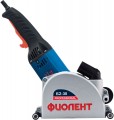Power consumed when operating an electric tool (see “Type”). Essentially, this is the power of the electric motor installed in the tool.
This indicator primarily determines electricity consumption and connection requirements. Thus, devices with a power of up to 3.5 kW can operate from a regular 230 V outlet; at higher values, as a rule, a connection to a 400 V network is required.
Also, based on power consumption, the general capabilities of tools are often assessed and compared - operating speed, ability to cope with hard materials, etc. Technically, this is not entirely true, since such characteristics depend not on the consumed, but on the useful power (see above). However, the latter is indicated relatively rarely in the characteristics, and the difference in energy consumption most often more or less corresponds to the difference in output power. So it is quite possible to say that the
higher the power consumption, the “stronger” the tool as a whole, the greater the cutting depth and operating speed it can provide, and the better suited for hard materials.
The maximum speed of rotation of the disk / cutter provided by the tool.
The higher the speed, the higher the speed of the cutting edge relative to the material, the higher the processing speed and the more accurate the cut is. On the other hand, as the speed increases, the torque decreases. So for the same blade/cutter diameter, higher RPMs will be beneficial on relatively soft materials, while a slower tool will be better for hard and stubborn materials.

